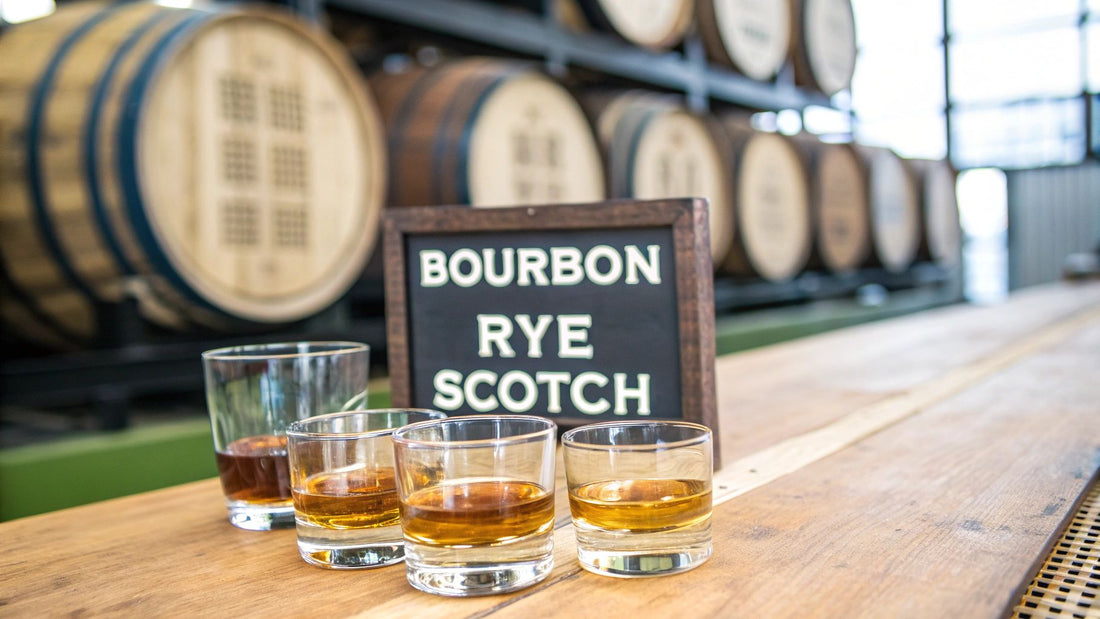When you're trying to figure out where to start with whiskey, the big question usually comes down to three choices: bourbon, rye, or scotch. At their core, the differences boil down to their main ingredients and the distinct flavors they produce.
Think of it this way: bourbon is a sweet, full-bodied American whiskey made from corn, rye is its spicy, peppery American cousin made from rye grain, and scotch is a complex whisky from Scotland, crafted primarily from malted barley and often carrying those famous smoky notes.
Decoding the World of Whiskey
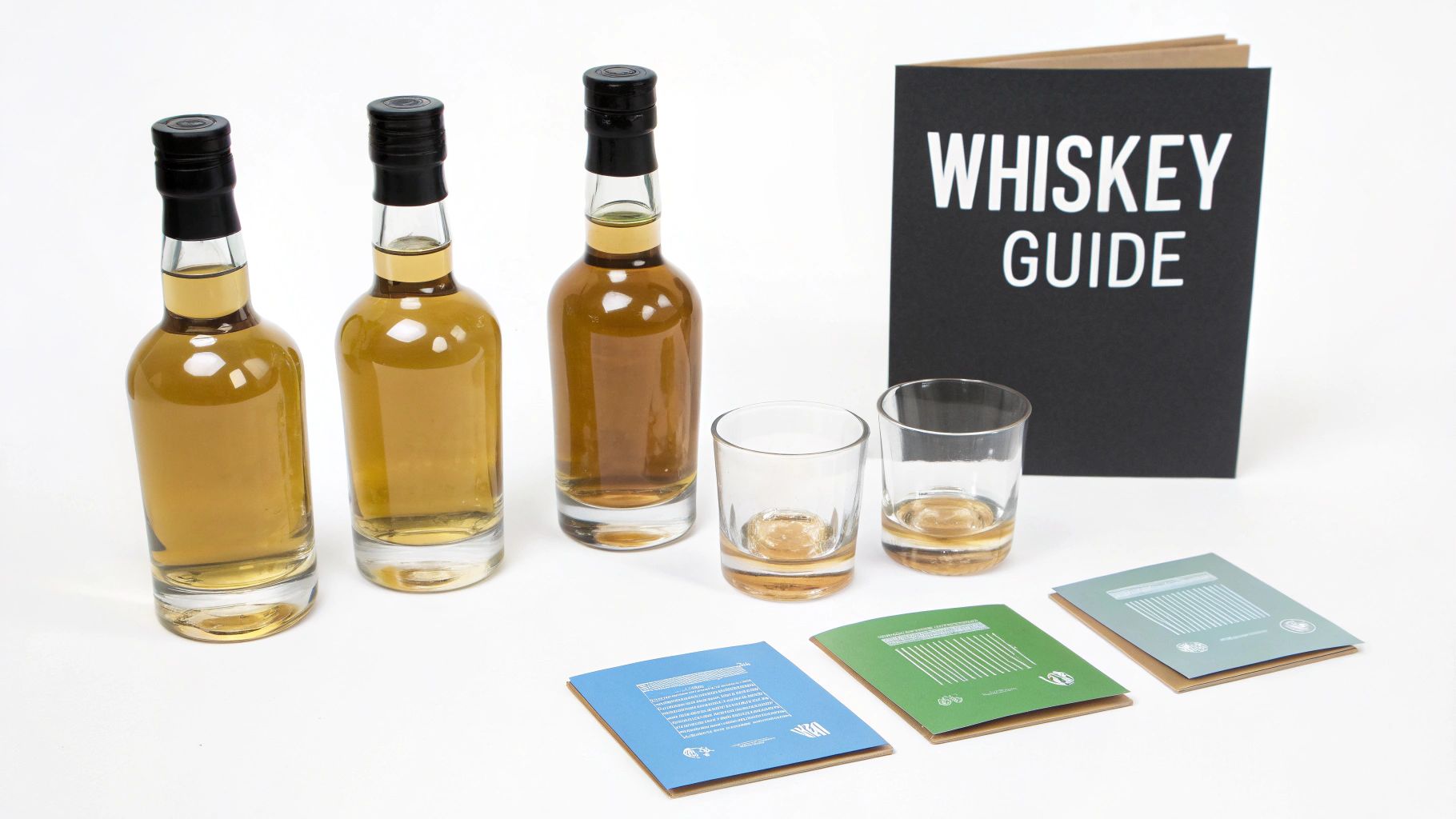
Walking into a well-stocked liquor store for the first time can be intimidating. You're faced with a wall of bottles—all different shapes, colors, and names, but all falling under the massive "whiskey" umbrella. The best way to cut through the noise is to understand the fundamental distinctions between the big three.
Each of these spirits tells a story shaped by its geography, history, and the strict laws that govern its production. This guide is here to break down those essential characteristics, so you can walk into that store with confidence. We'll touch on the iconic global brands, of course, but also shine a light on the incredible spirits coming from American craft distilleries that are really pushing the boundaries of these classic styles.
For a new whiskey drinker, the journey often starts with a simple question: "Where do I begin?" The answer depends entirely on your palate. If you enjoy sweeter flavors like caramel and vanilla, bourbon is a natural first step. If you prefer a bit of spice, rye offers an invigorating alternative.
The global fascination with these spirits isn't slowing down. In a recent year, worldwide whisky exports hit a staggering 1.4 billion bottles, marking a 3.9% increase in volume. That's a lot of demand. You can explore more global whisky export insights to see just how these trends are shaping the market.
Bourbon vs Rye vs Scotch At a Glance
To get a quick handle on the bourbon vs rye vs scotch debate, this table is your cheat sheet. It lays out the core differences before we get into the nitty-gritty of what makes each one so unique.
| Whiskey Type | Primary Grain | Primary Origin | Typical Flavor Profile |
|---|---|---|---|
| Bourbon | At least 51% Corn | United States | Sweet, full-bodied, with notes of caramel, vanilla, and oak. |
| Rye | At least 51% Rye | United States | Spicy, peppery, and often fruity with a drier finish than bourbon. |
| Scotch | 100% Malted Barley | Scotland | Varies widely by region; can be smoky, peaty, floral, or fruity. |
This snapshot gives you the lay of the land, but the real fun begins when you start exploring the nuances behind these simple descriptions.
Understanding Bourbon: The All-American Spirit
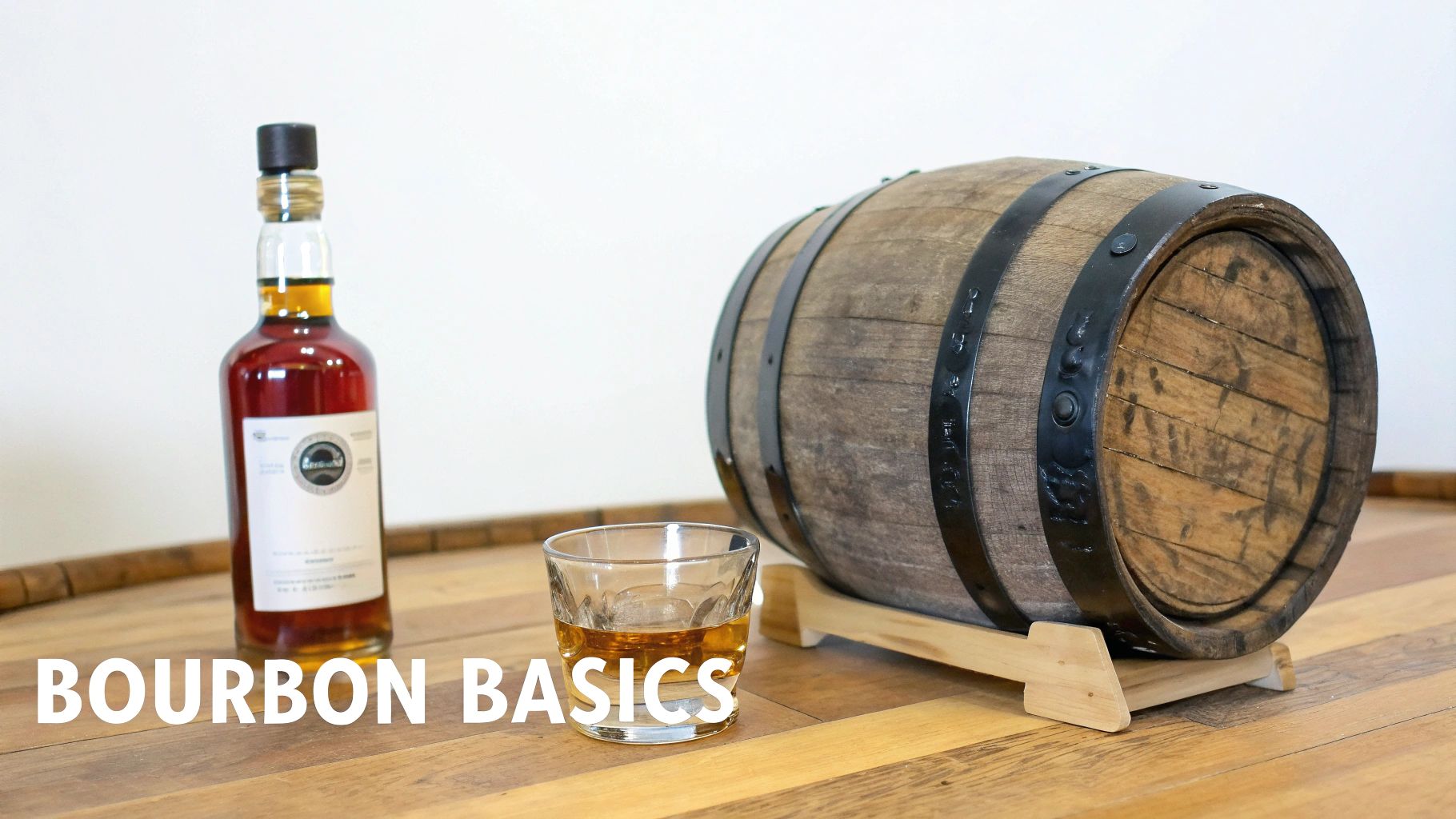
Often called “America’s Native Spirit,” bourbon is more than just a drink—it’s a legally protected piece of American heritage. To earn its name, a whiskey has to follow a very specific set of rules. These regulations are exactly what give bourbon its signature sweet, full-bodied character and make it a fantastic starting point for anyone new to whiskey.
At the heart of every bourbon is its grain recipe, or mash bill. The law dictates this recipe must contain at least 51% corn. It's this high corn content that lays the foundation for bourbon's trademark sweetness, which often comes through as notes of caramel, vanilla, and warm honey.
The aging process is just as crucial. Bourbon must be aged in new, charred oak barrels, a strict requirement that really sets it apart from many other whiskies around the globe. This is where the magic happens. As the spirit rests in the barrel, it pulls out color and a ton of complex flavors like toasted oak, baking spice, and brown sugar straight from the wood.
The Rules That Define Bourbon
To really get what makes a bourbon a bourbon, you have to know the rules. These aren't just casual guidelines; they're federal laws that every distiller must follow to the letter.
- Made in the USA: While most people think of Kentucky, bourbon can legally be made anywhere in the United States.
- 51% Corn Mash Bill: As we covered, corn has to be the star of the show, bringing that essential sweetness.
- New, Charred Oak Containers: The barrels can only be used once for bourbon. This single-use rule is key to its deep color and rich flavor profile.
- Distillation & Barrel Entry Proof: The spirit can't be distilled to more than 160 proof (80% ABV). When it goes into the barrel for aging, it must be no more than 125 proof (62.5% ABV).
These aren't just arbitrary numbers; they ensure a consistency and quality that drinkers have come to expect. It's this reliability that has helped the U.S. bourbon market grow to an estimated value of $19.35 billion. In fact, North America now accounts for over 35% of the global revenue, all driven by a growing thirst for premium spirits.
A Gateway for New Drinkers
For anyone just dipping their toes into the world of whiskey, bourbon's approachable sweetness and rich flavor make it the perfect entry point. You can find a classic taste from the iconic Kentucky distilleries, but the American craft whiskey scene is also exploding with producers putting their own unique spin on the spirit.
Tip for New Drinkers: Start with a lower-proof bourbon, something around 90 proof (45% ABV). Its softer profile is much easier on the palate and perfect for sipping neat or with a single large ice cube. This allows you to pick out the individual flavors without being overwhelmed by the alcohol. If you want some solid suggestions, our guide on the best bourbon for drinking straight is a great place to start.
As you get more comfortable, you might even want to explore other unique American spirits like American moonshine to get a fuller picture of the country's distilling heritage. From the historic distilleries of Kentucky to innovative craft producers like Laws Whiskey House in Colorado or Balcones in Texas, bourbon offers a delicious taste of American history in every single glass.
Exploring Rye Whiskey: The Spicy Contender
If bourbon is the sweet, charismatic star of American whiskey, then rye is its sharp, spicy, and historically rich older brother. For a long time, rye played second fiddle to its corn-based cousin, but it’s making a massive comeback. Both craft distillers and cocktail lovers are celebrating its bold character, making it a crucial player in the bourbon vs. rye vs. scotch debate.
Just like bourbon, American rye whiskey has to follow a strict rulebook. The mash bill must contain at least 51% rye grain, and the spirit has to be aged in new, charred oak barrels. That primary grain is exactly where rye gets its signature punch—a distinct kick of black pepper, baking spices like clove and cinnamon, and often a subtle herbal or fruity note that leads to a drier, crisper finish.
The Spice Spectrum in Rye
One of the first things to understand is that not all ryes are created equal. The actual percentage of rye in the mash bill creates a whole spectrum of flavors.
- "Barely Legal" Ryes (51-60% Rye): These are the whiskeys that just meet the legal minimum. The rest of the mash bill, usually corn and malted barley, rounds out the sharp edges of the rye, creating a smoother and slightly sweeter profile. They're a perfect bridge for bourbon drinkers looking to explore.
- High-Rye Whiskeys (70%+ Rye): This is where you get the full, unadulterated spice that rye is famous for. These bottles are intensely peppery, bold, and complex. They're a favorite for classic cocktails like the Manhattan or Sazerac because they have the backbone to stand up to other strong ingredients without getting lost.
Tip for New Whiskey Drinkers: If you're just dipping your toes into rye, try starting with one from a craft distillery that uses a "barely legal" mash bill. Brands like Maryland's Sagamore Spirit are known for creating incredibly balanced ryes that showcase the grain's character without overwhelming your palate.
A Revival of American History
Long before bourbon became king in Kentucky, rye was America's original spirit, with a deep-rooted tradition in states like Pennsylvania and Maryland. Today, craft distillers are spearheading the revival of these historic styles. You can get the full story by diving into the history of rye, America's true native spirit.
These producers aren't just dusting off old recipes; they're pushing the category forward. Distilleries like WhistlePig in Vermont and High West in Utah have built their reputations on sourcing and bottling phenomenal rye whiskeys. Meanwhile, places like Dad's Hat in Pennsylvania are passionately bringing back the authentic Monongahela Rye style. This craft movement is a golden opportunity for drinkers to explore the incredible range of what this spicy contender can truly offer.
Decoding Scotch Whisky: A World of Flavor
Leaving America behind, our journey takes us across the Atlantic to Scotland. Here, whisky (spelled without the "e") is more than just a drink—it’s a centuries-old tradition shaped by law, landscape, and legacy. The world of Scotch is vast, but it all starts with two major categories.
First up is Single Malt Scotch, often seen as the pinnacle of the craft. To earn that title, it must be made from 100% malted barley at a single distillery and aged for at least three years in oak casks. This tight focus on one grain and one location lets the unique character of the distillery and its region really shine through.
Then you have Blended Scotch Whisky, which actually makes up the vast majority of Scotch sold around the world. This is a masterful combination of one or more single malts with one or more single grain whiskies (often made from corn or wheat) from different distilleries. The art of blending is all about creating a consistent, balanced, and approachable flavor.
The Five Regions of Scotch
What truly sets Scotch apart is its powerful sense of place, or terroir. Scotland is divided into five (sometimes six) distinct whisky-producing regions, each lending a signature style to its spirits. Getting to know these regions is the key to navigating the incredible diversity of flavors Scotch has to offer.
- Speyside: Famous for its light, sweet, and fruity whiskies, often packed with notes of apple, honey, and vanilla. This region has the highest concentration of distilleries in Scotland.
- Highlands: As the largest region, it offers a massive range of styles, from rich and textured drams to delicate, floral spirits.
- Lowlands: Traditionally produces gentle, soft, and floral whiskies. Their approachable nature makes them an excellent starting point for anyone new to Scotch.
- Islay (pronounced EYE-lah): This island is legendary for its powerful, smoky, and peated whiskies, which carry distinct maritime notes of salt and seaweed.
- Campbeltown: Once a major whisky hub, this small region is known for producing robust, complex, and slightly briny spirits.
Tip for New Drinkers: For a newcomer, the term 'peat' can be a bit of a mystery. Peat is basically decomposed vegetation that’s burned to dry the malted barley, and it imparts a smoky, medicinal flavor. An Islay Scotch like Laphroaig or Ardbeg is a full-on peat experience, while a Speyside like Glenlivet is typically unpeated and much fruitier.
Scotch remains a global powerhouse. Despite some market headwinds, Scotch whisky exports were recently valued at an incredible £5.4 billion. What's really interesting is that while the value saw a slight dip, the volume shipped actually rose by 3.9%. This just goes to show how resilient consumer demand is for this iconic spirit.
You can get a better sense of how the market is shifting by diving into the latest whisky industry news and trade shifts. Ultimately, this incredible diversity—from sweet and floral to intensely smoky—is what makes exploring Scotch such a rewarding adventure.
Choosing Your Whiskey: A Practical Guide
Alright, you've got the basics down on what makes bourbon, rye, and scotch different. Now for the fun part—actually picking a bottle. Once you have a handle on their core flavors, you can walk into a bar or liquor store and choose something with confidence.
Think of it like this: if your palate leans towards sweeter things like caramel, vanilla, or dark fruits, a classic Kentucky bourbon is probably your best bet. Its corn-based profile is famously approachable and deeply satisfying, making it an ideal entry point into the world of American whiskey.
But if you're someone who enjoys a bit of a kick—think spicy, peppery, or even herbal notes—then rye whiskey will be right up your alley. That bold character is what makes it a star in classic cocktails, but it also provides a drier, more assertive experience when sipped neat.
And for the adventurous drinkers drawn to complex, savory, and sometimes smoky profiles? Scotch is a massive, incredible world to get lost in. You could start with a gentle, fruit-forward dram from a Speyside distillery or jump right into the deep end with a peaty, salty single malt from Islay.
This simple breakdown shows how to think about the two main categories of Scotch you'll see on the shelf.
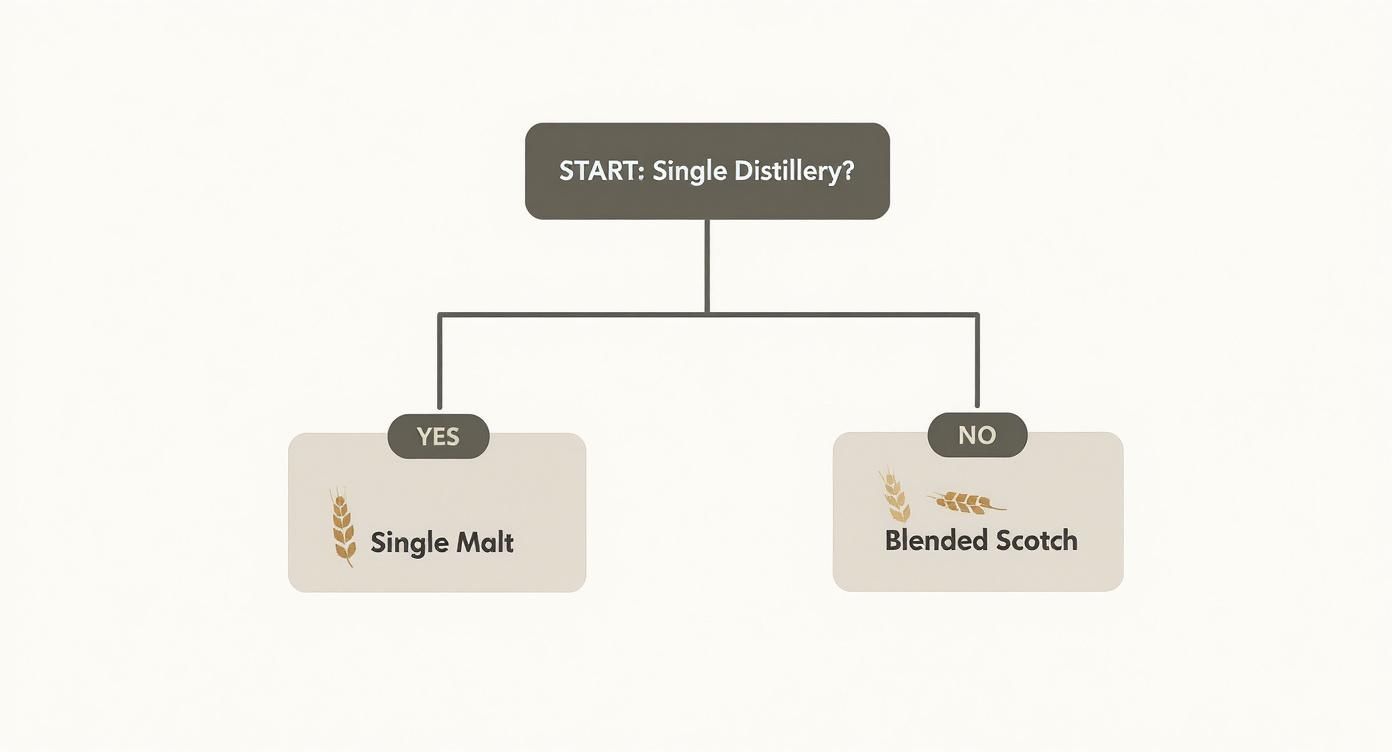
As you can see, Single Malt is all about the unique character of one single distillery, while Blended Scotch brings together whiskeys from multiple producers for a different kind of harmony.
Recommendations For Your First Pour
To make things even easier, here are a few highly-regarded and easy-to-find bottles. I've included both iconic brands and some fantastic American craft distillery options to get you started.
For the Bourbon Beginner:
- Classic Choice: Buffalo Trace is famous for a reason. It nails that perfect balance of sweetness with notes of toffee and vanilla, making it an absolutely flawless entry-level bourbon.
- Craft Pick: Frey Ranch Straight Bourbon from Nevada is a stellar example of a "four-grain" mash bill. It's wonderfully complex yet incredibly smooth, proving just how good modern craft whiskey can be.
For the Aspiring Rye Enthusiast:
- Classic Choice: Rittenhouse Rye is a bartender’s secret weapon. Its bold spice is exactly what a Manhattan needs, but it’s still smooth enough to sip and enjoy on its own.
- Craft Pick: Sagamore Spirit Signature Rye Whiskey out of Maryland is a fantastic expression of a balanced, approachable rye that delivers both spice and smoothness.
Tip for New Drinkers: Here's a pro tip for anyone just starting out: find a good whiskey bar and order a tasting flight. It lets you try a bourbon, a rye, and a scotch side-by-side in small pours. You'll discover what you truly enjoy without having to commit to a full bottle.
Which Whiskey Should You Try First?
Still on the fence? This little guide should help you narrow it down based on your existing tastes.
| If You Like Flavors That Are... | Your Best Starting Point Is... | Why It's a Good Fit | Classic Cocktail to Try |
|---|---|---|---|
| Sweet & Rich (caramel, vanilla, oak) | Bourbon | It's the most approachable and naturally sweet of the three, making for a smooth introduction. | Old Fashioned |
| Spicy & Bold (black pepper, baking spice) | Rye | Its assertive, peppery kick offers a drier and more complex flavor experience. | Manhattan |
| Fruity & Floral (apples, pears, honey) | Speyside Scotch | This style is light and unpeated, focusing on the delicate flavors from the malt and cask. | Rob Roy |
| Smoky & Savory (campfire, brine, earth) | Islay Scotch | For the adventurous, this is a dive into the deep end of complex, peated whisky. | Penicillin |
Ultimately, the best way to find your favorite is to start tasting. Don't be afraid to try something new—you might just be surprised by what you end up loving.
How to Taste and Mix Your First Whiskey
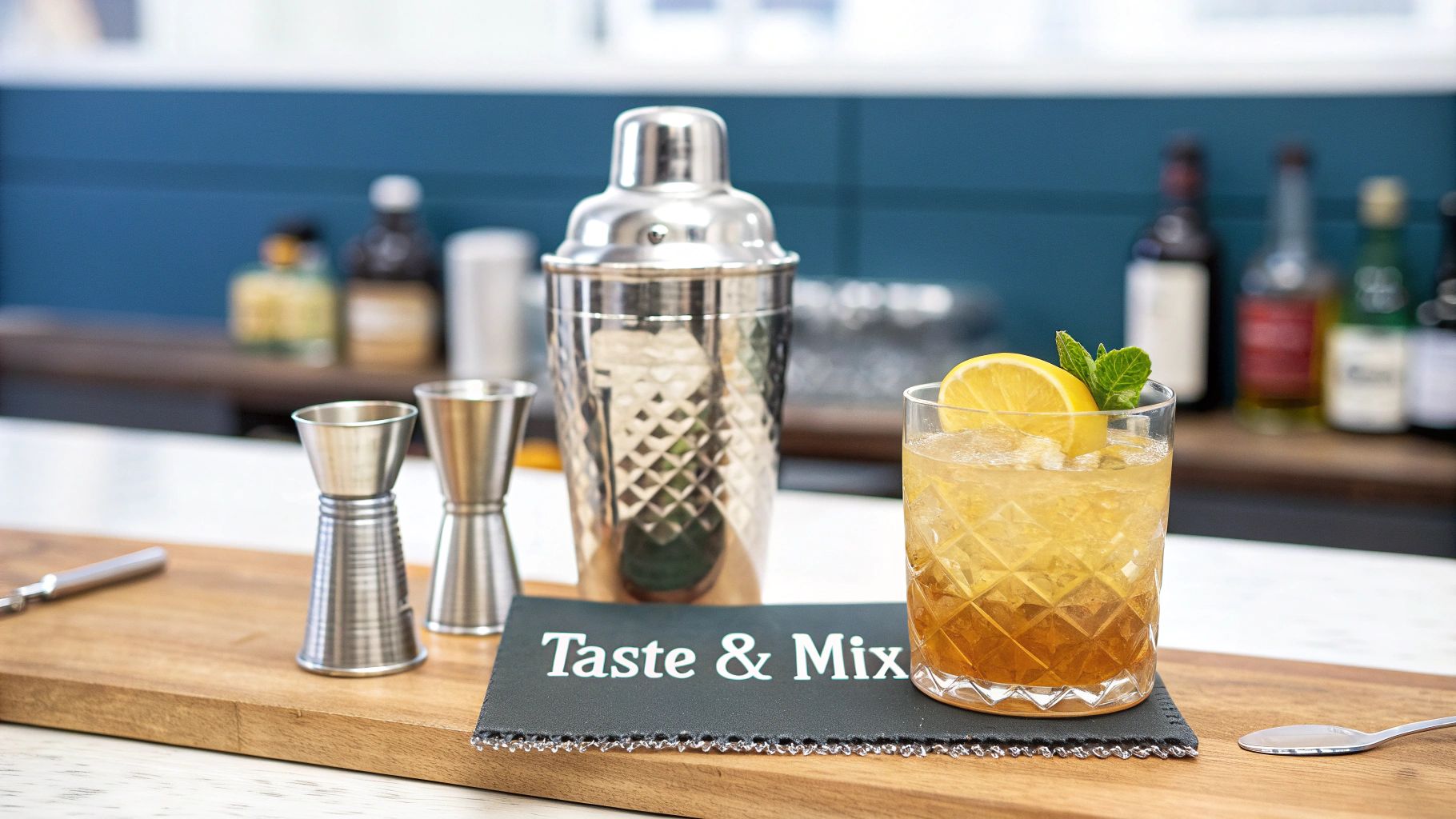
Alright, moving from the books to the bar—this is where the real fun starts. Properly tasting whiskey isn't about being pretentious; it's about appreciating the full spectrum of aromas and flavors that distillers work so damn hard to create. The process is a lot simpler than you might think, and it turns a simple drink into a genuine experience.
If you’re just getting started, the biggest key is to just slow down. Pour a small amount into a glass, give it a gentle swirl, and bring it up to your nose. Inhale softly. You want to pick up the initial scents without getting a face full of alcohol. After nosing it, take a tiny sip and let it coat your palate before swallowing.
Want to really dial in your technique? We’ve put together a complete guide on how to taste whiskey like an expert.
Simple Cocktails to Start Your Journey
Making classic cocktails at home is a fantastic way to understand how the unique character of each whiskey type truly shines. The distinct profiles in the bourbon vs rye vs scotch lineup are exactly what make them perfect for different drinks.
Here are three timeless, dead-simple recipes to get you started:
1. The Bourbon Old Fashioned
Bourbon’s natural sweetness is the perfect foundation for this absolute icon of a cocktail. Its inherent notes of caramel and vanilla play beautifully with the sugar and bitters.
- In a glass, muddle 1 sugar cube with 2 dashes of Angostura bitters.
- Add 2 oz of a quality American craft bourbon, like Westward Whiskey from Oregon.
- Stir with a large ice cube until it’s perfectly chilled, and garnish with a fresh orange peel.
2. The Rye Manhattan
Rye’s spicy, peppery kick gives it the necessary backbone to stand up to sweet vermouth, creating a flawlessly balanced and robust cocktail. This isn't a drink that gets lost in the mix.
- Combine 2 oz of rye whiskey with 1 oz of sweet vermouth in a mixing glass filled with ice.
- Add 2 dashes of Angostura bitters and stir until it's seriously well-chilled.
- Strain it into a coupe glass and drop in a brandied cherry for the final touch.
3. The Scotch Rob Roy
Think of this as a Manhattan that took a trip to Scotland. It swaps rye for Scotch, offering a completely different dimension of flavor depending on which whisky you choose. A good blended Scotch works wonders here.
- Combine 2 oz of blended Scotch whisky with ¾ oz of sweet vermouth in a mixing glass with ice.
- Add 1-2 dashes of bitters, stir it all together, and strain into a chilled glass.
- Garnish with a lemon twist or a cherry.
Answering Your Whiskey Questions
Diving into the world of bourbon, rye, and scotch can feel a little overwhelming at first. It's a journey with a lot of new terms and tastes, so it's natural to have questions. Let's clear up a few of the most common ones.
What’s the Best Whiskey to Start With?
If you're just starting out, bourbon is almost always the best place to begin. Its foundation is corn, which gives it a natural sweetness and a smoother, more rounded character. Think notes of caramel, vanilla, and oak—flavors that are generally much more approachable than the peppery spice of a rye or the intense smoke of certain scotches.
A great way to get started is with a quality, lower-proof bottle (somewhere around 90-proof) from an American craft distillery like Frey Ranch. You'll get a real sense of what a modern, beautifully balanced bourbon can be.
A Quick Tip for Newcomers: Don't let anyone tell you there's a "wrong" way to drink it. There's no shame in adding a splash of water or a single large ice cube. In fact, it's a great way to open up the whiskey's aromas and soften the initial alcohol burn, making those first sips far more enjoyable.
Is Scotch the Same as Bourbon?
Not at all. While they're both types of whiskey, scotch and bourbon are completely different spirits, each with its own strict, legally protected identity.
- Place of Origin: Scotch has to be made in Scotland. Bourbon has to be made in the United States. No exceptions.
- The Main Ingredient: Scotch is built on a base of malted barley. Bourbon, on the other hand, must be made from at least 51% corn.
- The Taste: These base ingredients create two vastly different worlds of flavor. Scotch can be anything from light and fruity to peaty and intensely smoky, while bourbon consistently delivers a richer, sweeter profile.
It's also fascinating to see how distillers market these differences. The business side of the spirits world is all about creating distinct identities for each category. If you're curious about how that works behind the scenes, there are some great reads on the digital marketing budget allocation for liquor brands that show how they build such unique personalities for these whiskeys. It really helps explain why they feel so different when you see them on the shelf.
The only real way to know what you truly like is to taste for yourself, without any preconceived notions. At Blind Barrels, we make that easy. Our quarterly tasting kits feature four incredible American craft whiskeys, all tasted blind, so you can discover your next favorite based on nothing but pure flavor. Ready to start the adventure? Explore our whiskey tasting subscription today.
